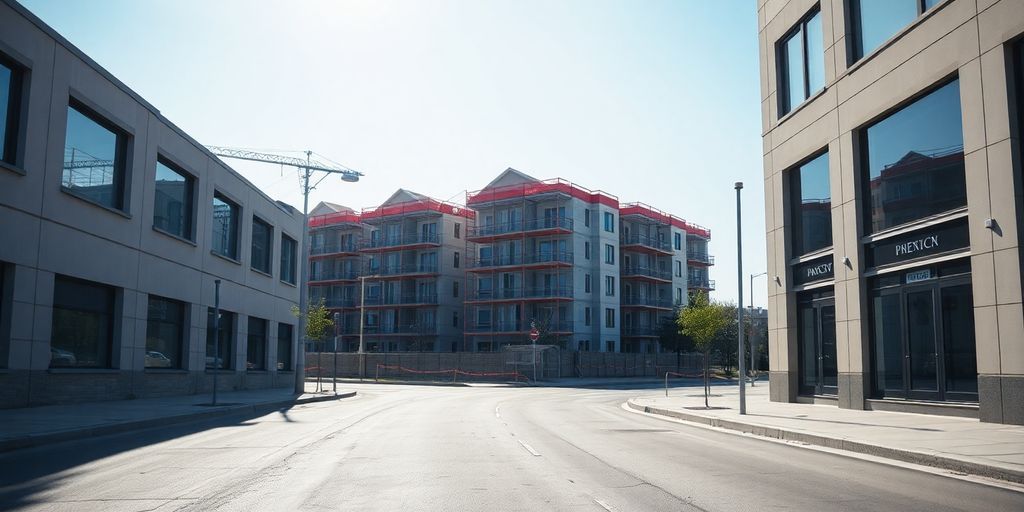Understanding the New York Real Estate Market Landscape
Blog Author - Published Date
So, you're thinking about getting into the New York real estate market? It's a big step, for sure. This city's property scene is pretty unique, and it can feel a bit much if you're new to it. But don't worry, this guide is here to help. We'll walk you through everything, from figuring out the market's quirks to finding your way through buying, selling, or even just renting a place. It's all about making smart choices, and we're going to show you how.
Key Takeaways
- New York's property market is always changing, so staying informed is a must.
- There are lots of different types of properties here, from apartments to houses, each with its own rules.
- Getting your money in order early on makes everything a lot smoother.
- For renters, knowing what you want and asking good questions can save you a lot of trouble.
- Always get legal help for any big property deals in New York.
Key Characteristics of the New York Real Estate Market
New York City's real estate market is unlike any other. It's fast-paced, competitive, and heavily influenced by global economic trends. Understanding these core traits is the first step for anyone looking to buy, sell, or rent here. The market's density and limited space drive up prices, and demand often outstrips supply, especially in prime locations. Urban vs. suburban trends play a big role, with each borough offering a different experience and price point. You'll find everything from luxury condos in Manhattan to single-family homes in Staten Island, each with its own set of pros and cons.
Market Segments and Property Types
The NYC real estate market can be broken down into several key segments:
- Residential: This includes condos, co-ops, townhouses, and single-family homes. Condos offer direct ownership, while co-ops involve buying shares in a corporation that owns the building. Each has different rules and fees.
- Commercial: Office spaces, retail locations, and industrial properties make up this segment. These investments often require a larger initial investment but can yield significant returns.
- Rental: A huge part of the NYC market, with apartments ranging from studios to multi-bedroom units. Rent control and stabilization laws can affect rental income and property values.
Economic Resilience and Appreciation History
New York City real estate has historically shown strong economic resilience. Even during downturns, the market tends to bounce back faster than many other areas. This is due to the city's status as a global hub for finance, culture, and innovation. Buyer demographics are diverse, with both domestic and international investors driving demand. While past performance isn't a guarantee of future results, the long-term appreciation history of NYC real estate is a compelling factor for many investors.
Investing in New York real estate requires a long-term perspective. Market fluctuations are inevitable, but the city's enduring appeal and economic strength make it a solid investment for those willing to ride out the ups and downs.
Strategies for Successful Property Investment
Identifying Investment Opportunities
Okay, so you want to make some money in New York real estate? Good luck! It's tough, but not impossible. First, you gotta figure out where to even look. Don't just jump at the first shiny listing you see. Do your homework.
- Market Trends: Keep an eye on what's happening. Are prices going up or down? What neighborhoods are hot? What are the economic indicators saying?
- Property Types: Think about what kind of property you want. Condo? Co-op? Multi-family? Each has its own pros and cons. Condos are easier to manage, but townhouses might appreciate more.
- Neighborhood Analysis: Some neighborhoods are up-and-coming. Others are established and stable. Which one fits your risk tolerance? Look at schools, transportation, and crime rates.
Don't be afraid to dig deep. Talk to locals, read the news, and really get a feel for the area before you drop a ton of cash. It's better to be safe than sorry.
Navigating Financing Options
Alright, you found a place you like. Now comes the fun part: paying for it. Unless you're swimming in cash (lucky you!), you'll need a mortgage. But which one? There are a million options, and they all sound confusing.
- Mortgage Types: Fixed-rate, adjustable-rate, FHA, VA... the list goes on. Talk to a few different lenders and see what they offer.
- Down Payment: How much can you afford to put down? The more you put down, the lower your monthly payments will be. But don't drain your savings account.
- Credit Score: Your credit score is a big deal. The better your score, the better interest rate you'll get. Check your credit report and fix any errors before you apply for a loan.
Getting pre-approved is a smart move. It shows sellers you're serious and gives you a better idea of what you can afford.
Long-Term Perspective for Wealth Building
Real estate isn't a get-rich-quick scheme. It's a long game. You need to be patient and think about the future. Don't expect to double your money overnight.
- Rental Income: If you're renting out your property, make sure the rent covers your mortgage, taxes, and other expenses. And don't forget to factor in vacancy periods.
- Property Appreciation: Over time, your property should increase in value. But there are no guarantees. The market can go up and down.
- Tax Benefits: Real estate has some nice tax advantages. You can deduct mortgage interest, property taxes, and depreciation. Talk to a tax advisor to see how these benefits can help you.
| Factor | Short-Term | Long-Term |
|---|---|---|
| Rental Income | Immediate | Consistent |
| Appreciation | Unpredictable | Gradual |
| Market Fluctuations | High Impact | Lower Impact |
Navigating the New York City Rental Market
Picking the Right Neighborhood
Finding the right neighborhood is the first step in tackling the NYC rental market. It's not just about the apartment itself, but also the vibe, the commute, and what's nearby. Think about what's important to you. Do you want a lively area with lots of restaurants and bars, or something quieter and more residential? Consider these factors:
- Commute: How long will it take you to get to work or school?
- Safety: Research crime rates and walk around the neighborhood at different times of day.
- Amenities: Are there grocery stores, parks, and other things you need nearby?
Choosing a neighborhood is a very personal decision. What works for one person might not work for another. Take your time, do your research, and visit different areas before making a decision.
Maximizing Your Rental Budget
Knowing your budget is key. New York City is expensive, and rent is often the biggest expense. Figure out how much you can realistically afford each month, considering all your other expenses. Don't forget to factor in things like utilities, internet, and renter's insurance. Here's a simple breakdown:
- Calculate your monthly income after taxes.
- List all your fixed expenses (student loans, car payments, etc.).
- Subtract your fixed expenses from your income to see how much you have left for rent and other variable expenses.
Consider these options to maximize your budget:
- Look for apartments in less popular neighborhoods.
- Consider living with roommates to split the cost.
- Be willing to compromise on size or amenities.
Working with a Real Estate Broker
Deciding whether or not to use a real estate broker in the NYC rental market is a big question. Brokers can be helpful, especially if you're new to the city or don't have a lot of time to search on your own. They have access to listings that you might not find on your own, and they can help you negotiate with landlords. However, brokers also charge a fee, which can be a significant expense. Here's what to consider:
- Pros: Access to more listings, help with negotiations, saves time.
- Cons: Broker fees can be high, potential for pushy sales tactics.
- Alternatives: Online rental platforms, networking with friends and colleagues.
Here's a table comparing the costs:
| Scenario | Broker Fee (Typical) | Time Spent Searching | Stress Level |
|---|---|---|---|
| Using a Broker | 1 month's rent | Low | Medium |
| Searching on Your Own | $0 | High | High |
Essential Steps for Renting in New York City
Creating a List of Non-Negotiables
Before you even start browsing listings, sit down and make a list of your absolute must-haves. What are the things you simply cannot live without? Is it pet-friendly apartments? Maybe it's a specific neighborhood, a certain square footage, or in-unit laundry. Knowing your non-negotiables will save you a ton of time and heartache by preventing you from falling in love with places that just won't work for your lifestyle.
- Proximity to work or school
- Acceptable commute time
- Specific amenities (gym, doorman, etc.)
It's easy to get caught up in the excitement of apartment hunting, but sticking to your non-negotiables will ensure you end up in a place that truly meets your needs. Don't compromise on the things that are most important to you.
Asking the Right Questions During Viewings
Don't be shy! Viewings are your chance to gather all the information you need to make an informed decision. Go beyond the surface and ask about things like the building's management, the average utility costs, and the noise level at different times of day. It's also a good idea to inquire about the building's history – have there been any recent issues with pests or repairs?
- What is the building's pet policy?
- How often is the building cleaned?
- What are the typical utility costs?
Securing Your Dream Apartment
So, you've found the perfect place – now what? Be prepared to act fast! The NYC rental market moves quickly, so having all your documents in order is key. This includes things like your credit report, proof of income, and letters of recommendation. Submitting a complete and well-organized application will show landlords that you're a serious and responsible tenant.
- Gather all necessary documents (credit report, pay stubs, etc.).
- Write a cover letter introducing yourself.
- Be prepared to pay the security deposit and first month's rent immediately.
Legal Considerations in New York Real Estate
Understanding Property Purchase and Sale Agreements
When you're buying or selling property in New York, the purchase and sale agreement is everything. It's a legally binding contract that outlines the terms of the transaction. Make sure you read it carefully and understand every clause before signing. It's not just a formality; it protects both the buyer and the seller.
- Review all contingencies (financing, inspection, etc.).
- Clarify responsibilities for repairs and closing costs.
- Understand the implications of default.
Importance of Legal Counsel in Transactions
Having a lawyer during a real estate transaction in New York isn't just a good idea, it's almost a necessity. The laws can be complex, and a lawyer can help you avoid costly mistakes. They can review contracts, negotiate terms, and represent your interests throughout the process. Plus, they can explain all those confusing legal considerations in plain English.
Trying to go it alone can save you money upfront, but it could cost you much more in the long run if something goes wrong. A good real estate attorney is worth their weight in gold.
Common Real Estate Litigation Matters
Real estate disputes can arise for many reasons. Here are a few common ones:
- Boundary disputes with neighbors.
- Breach of contract claims (failure to close, etc.).
- Title issues (problems with ownership).
- Failure to disclose property taxes or defects.
If you find yourself in a real estate dispute, it's important to seek legal advice as soon as possible. Litigation can be expensive and time-consuming, so it's best to try to resolve the issue through negotiation or mediation first. But if that doesn't work, you need to be prepared to fight for your rights in court.
Resources for New York Real Estate Beginners
So, you're thinking about getting into the New York real estate game? Awesome! It can seem intimidating, but with the right info, you can totally do it. Here's where to find some solid resources to get you started.
Official Government and Market Data Sources
First things first, you gotta know where to find the real numbers. Don't just rely on what you hear from your cousin's friend who knows a guy. Go straight to the source. The NYC Department of Buildings website is a goldmine for permits, violations, and all sorts of property info. StreetEasy Market Reports are also super helpful for understanding pricing trends in different neighborhoods. And don't forget the NYC Rent Guidelines Board publications if you're thinking about rentals. These resources give you a fact-based foundation for making smart decisions.
Local Investment Associations and Forums
Okay, now that you've got the data, it's time to connect with other people. Local real estate investment associations are great for networking and learning from experienced investors. They often host workshops and seminars that are perfect for beginners. Neighborhood-specific online forums can also be super useful for getting the inside scoop on specific areas. You can find out about upcoming developments, local issues, and even off-market deals. It's all about building your network and learning from others. For example, you can learn about first-time homebuyer programs in the Hudson Valley.
Continuous Education for Market Success
The New York real estate market is constantly changing, so you can't just learn everything once and then call it a day. You need to commit to continuous education. Read industry publications, attend webinars, and follow market experts on social media. The more you learn, the better equipped you'll be to make smart investment decisions. Plus, staying up-to-date on the latest trends will help you spot opportunities that others might miss.
Here's a quick list of things to keep an eye on:
- Changes in interest rates
- New zoning regulations
- Emerging neighborhood trends
- Economic indicators
Wrapping Things Up
So, there you have it. New York real estate can seem like a lot, right? But honestly, with a bit of homework and the right people helping you out, it's totally doable. Don't rush into anything, and always ask questions. Whether you're looking to buy a place or just rent, knowing what's what will make a big difference. It's a big city, with lots of options, and finding your spot here is a pretty cool thing.
Frequently Asked Questions
What makes the New York real estate market different from others?
New York City's real estate market is special because it's always in demand. Property values tend to go up over time, and there are always people looking to rent. This makes it a pretty safe bet for investors, even when other markets are struggling.
How can I find good investment opportunities in New York real estate?
To find good deals, you should look at different parts of the city and see what's available. Think about what kind of property you want, like an apartment or a house. Also, it's smart to work with a good real estate agent who knows the local market well.
What are the best tips for renting an apartment in New York City?
When renting in NYC, try to be flexible with your neighborhood choice. Think about what you really need versus what you just want. Having a clear budget and knowing what you can afford is super important. Also, don't be afraid to work with a real estate agent; they can save you a lot of time and hassle.
What are the key steps to securing a rental in NYC?
Before you start looking, write down a list of things you absolutely must have in an apartment, like the number of bedrooms or if it has laundry. When you go to see places, ask lots of questions about the building, the neighbors, and any extra costs. Once you find a place you like, be ready to act fast because good apartments go quickly!
Why is legal help important when dealing with New York real estate?
Buying or selling property involves legal papers called purchase and sale agreements. It's really important to have a lawyer look over these documents to make sure everything is fair and legal. Sometimes, problems come up, like arguments over property lines or building issues, and a lawyer can help you deal with those.
Where can beginners find reliable information about New York real estate?
There are many places to get information. You can check out official government websites for housing data, or look at market reports from real estate companies. Joining local real estate groups or online forums can also connect you with experienced investors who can share their knowledge.














